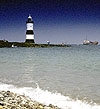
Trywn Du (TH) |
Photo with the kind permission of Trinity House. Please note that any items in RED means there is a fuller version relating to this particular name or subject, which can be found in the Main Search index. POSITION 53° 18’.80 N 04° 02’.40 W Location: Small island off North Coast of Dyfed (Wales) Admiralty List of Lights Ref: 5140 Present Lighthouse Established: 1838 Designer: James Walker & John Burgess Resident Engineer: George Burrell Tower Composition: Circular local stone/masonry Height of tower: 95 ft 6 ins (29 m) Focal Height of Light: 62 ft 4 ins (19 m) above mean high water Light Characteristic: one white flash every 5.5 seconds Visible Distance on a Clear Night : nominal 15 nautical miles First Lit: 11th November 1838 Demanned: 1922 Solar power operations: 1996 The Island of Anglesey, off the coast of North Wales, must be rounded by coastal shipping making the passage up or down the western seaboard, and as a consequence of its position in a busy seaway has several major lights. Skerries was built first, followed a century later by South Stack and Point Lynas, the latter after the wreck of the "Rothesay Castle" on Puffin Island at the entrance to the Menai Straight in 1830. The Liverpool master pilots had already been consulted about the necessity for a light on the shore at Black Point, or Trwyn-du, but no action was taken until late in the 1830s when Trinity House built the present station at a cost of £11,589. The lighthouse is situated on a low-lying rock surrounded by shingle beaches about half a mile south of Puffin Island. The circular stone tower is distinguished by three black bands. The lighthouse was originally manned by two keepers, however these were withdrawn in 1922 when the lighthouse was converted to unwatched acetylene operation. Trwyn Du Lighthouse was converted to solar power in 1996, work to modernise the station included the development of a unique operating mechanism to work the 178 Kg fog bell. |